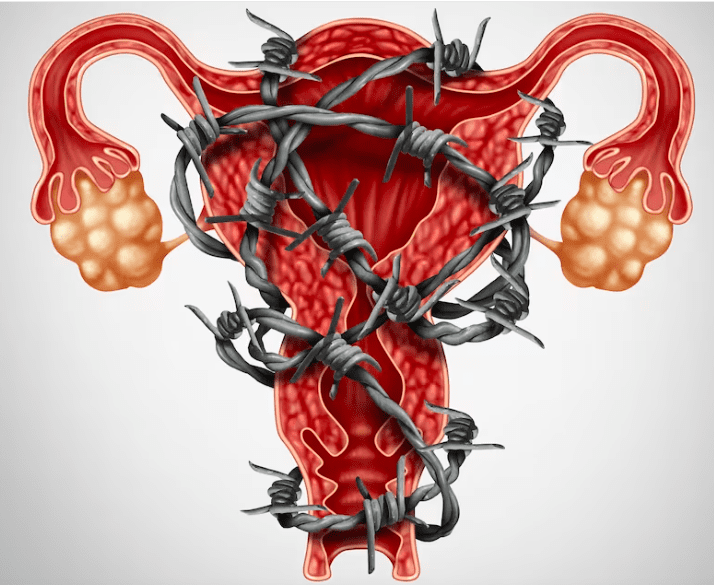Trending Stories
Novel Research Links Endometriosis to a Common Bacteria: Unveiling a New Frontier in Women’s Health

Novel Research Links Endometriosis to a Common Bacteria: Unveiling a New Frontier in Women’s Health
A Fresh Perspective on Endometriosis: The Role of Common Bacteria
In a significant breakthrough, recent research is illuminating a potential link between endometriosis, a chronic disease that inflicts excruciating pain on millions, and Fusobacterium – a strain of bacteria usually found in the mouth and digestive system.
Endometriosis, affecting roughly 10% of women worldwide and more than 11% in the United States, has long been a medical enigma, with the root cause remaining elusive. This lack of understanding has greatly limited the options for effective treatments.
Investigating the Fusobacterium-Endometriosis Connection
In a study published in the esteemed journal Science Translational Medicine, a team of Japanese researchers embarked on an exploratory journey, examining vaginal swab samples from 155 women. The participants included 76 healthy individuals and 79 endometriosis patients.
Surprisingly, 64% of the endometriosis group tested positive for the presence of Fusobacterium in their uterine lining. In stark contrast, the bacteria were found in fewer than 10% of the healthy participants.
From Mice to Humans: Translating the Findings
The team pushed forward with their investigation, using mouse models to further understand the role of Fusobacterium in the development of endometriosis.
Injection of the bacteria led to a notable increase in endometriotic lesions in the mice. Intriguingly, administration of antibiotics caused a significant reduction in both the number and weight of these lesions.
Shattering Prevailing Theories about Endometriosis
Although Fusobacterium is commonly linked with oral diseases such as periodontitis and tonsillitis, this marks the first time the bacteria has been implicated in issues with the female reproductive system.
This revolutionary discovery challenges conventional theories about endometriosis – a condition characterized by the abnormal growth of tissues similar to those in the uterine lining outside the uterus. Until now, researchers had attributed endometriosis to factors such as retrograde menstruation, genetic predisposition, or hormones.
Endometriosis and the Painful Path to Infertility
Endometriosis can result in severe menstrual cramps, and digestive issues, and can be a leading cause of infertility. Existing treatments for endometriosis, such as hormonal options like birth control, offer temporary relief at best.
The pain usually resumes once the patient stops taking the medication to attempt pregnancy. With 30 to 50 percent of endometriosis patients struggling with infertility, this creates a scenario of enduring severe pain while trying to conceive.
Hope on the Horizon: Harnessing the New Discovery for Therapeutic Advances
The newly discovered potential link between endometriosis and Fusobacterium might not immediately translate into a conclusive treatment.
However, this groundbreaking revelation opens up exciting avenues for future research and the development of more effective therapies for endometriosis.
Experts from the Stem Cell Biology and Regenerative Medicine Research Laboratory at Brigham and Women’s Hospital in Boston are urging the medical community to further investigate this finding.
They suggest a more extensive study of the microbiome in endometriosis patients from larger populations and explore potential interactions with other infectious agents causing inflammation and tissue changes.
Reframing the Understanding of Endometriosis?
While researchers remain cautious, acknowledging the preliminary nature of these findings, there’s palpable excitement in the air.
The study’s small sample size means that immediate large-scale changes to treatment, such as prescribing antibiotics, are not on the cards just yet.
However, these revelations open the doors to more targeted investigations and a deeper understanding of endometriosis.
Dr. Allison K. Rodgers, a reproductive endocrinologist at the Fertility Centers of Illinois who wasn’t part of this research, puts it aptly, “We’re still figuring out the ‘why’ of endometriosis, but once we understand it, we’ll be able to design targeted approaches for treatment.
Can Bacterial Infection Change the Course of Endometriosis
One of the study’s authors, Yutaka Kondo, a cancer biologist from Nagoya University Graduate School of Medicine in Japan, regards this research as a potential game-changer in women’s health care.
He remarked, “Previously, nobody thought that endometriosis came from a bacterial infection, so this is a very new idea.”
Stepping Stone for Future Breakthroughs in Women’s Health
The study is just a small piece of the puzzle in understanding endometriosis. However, its findings potentially alter the path of future research.
What was once thought of as a chronic disease, caused by genetic predisposition or hormonal imbalances, might indeed have a bacterial component.
Raymond Manohar Anchan, director of the Stem Cell Biology and Regenerative Medicine Research Laboratory, views the development with measured optimism, stating, “If this indeed holds true for other patients, it may be worth investigating the microbiome of patients with endometriosis from a larger population
Turning Over New Leaves in Endometriosis Research
As researchers continue to explore this new line of investigation, millions of women suffering from endometriosis are watching closely, hoping that this groundbreaking discovery will soon lead to more effective treatments.
These exciting new findings may represent a giant leap forward in understanding and managing this debilitating condition, offering new hope to women worldwide.
Relevant references: [link to the original Washington Post article], [link to the Science Translational Medicine journal where the study was published], [link to more information about Endometriosis from a credible health source], [link to more information about Fusobacterium from a credible health source].
Trending Stories
Sister Regina Liu: Empowering Health Through Acupuncture

Sister Regina Liu: Empowering Health Through Acupuncture
In the bustling world of healthcare, Sister Regina Liu stands out as a beacon of holistic healing. Her journey into the world of acupuncture is not only inspiring but also transformative for the countless individuals she has treated.
Through her dedication, Sister Regina has brought traditional Chinese medicine to the forefront, offering an alternative and complementary approach to modern medical practices.
The Journey of Sister Regina Liu
Sister Regina Liu’s path to becoming a renowned acupuncturist began with her deep-rooted interest in holistic health. Born into a family that valued traditional Chinese medicine, Sister Regina was exposed to the benefits of acupuncture from a young age. Her early fascination turned into a lifelong passion as she pursued formal education and training in the field.
Acupuncture: Bridging Ancient Wisdom and Modern Health
Acupuncture, a practice with origins in ancient China, involves inserting thin needles into specific points on the body to balance the flow of energy or “qi.” Sister Regina Liu has mastered this ancient art, using it to address a wide range of health issues.
From chronic pain to stress management, her expertise has provided relief to many who had exhausted conventional treatment options.
Impact on Community Health
Sister Regina’s impact extends beyond individual treatments. She has been instrumental in educating the community about the benefits of acupuncture, breaking down misconceptions, and making the practice more accessible.
Her workshops and seminars have enlightened many about the holistic approach to health, emphasizing the interconnectedness of body, mind, and spirit.
Success Stories and Testimonials
The success stories of Sister Regina’s patients are a testament to her skill and dedication. Many individuals who had lost hope found solace in her treatments.
For instance, Maria, a long-time sufferer of migraines, experienced significant relief after just a few sessions with Sister Regina. Her story is just one of many that highlight the transformative power of acupuncture under Sister Regina’s care.
Challenges and Triumphs
Like any journey, Sister Regina’s path was not without challenges. Integrating acupuncture into mainstream healthcare faced resistance initially.
However, her perseverance and the undeniable results of her treatments gradually won over skeptics. Today, Sister Regina is not only respected in the field of acupuncture but also in the broader medical community.
The Science Behind Acupuncture
While acupuncture is rooted in ancient practices, modern science has begun to unravel the mechanisms behind its effectiveness. Studies have shown that acupuncture can stimulate the release of endorphins, the body’s natural painkillers, and improve blood circulation.
These scientific validations have further cemented acupuncture’s place in contemporary healthcare, thanks in part to advocates like Sister Regina Liu.
Acupuncture in Modern Healthcare
Sister Regina’s work exemplifies how traditional practices can complement modern medicine. Hospitals and clinics increasingly incorporate acupuncture into their treatment plans, recognizing its benefits in pain management, mental health, and overall well-being. This integration signifies a broader acceptance and understanding of holistic health practices.
Future Vision
Looking ahead, Sister Regina Liu envisions a future where acupuncture and traditional Chinese medicine are fully integrated into the global healthcare system. She continues to advocate for research, education, and policy changes that support the inclusion of holistic practices in mainstream medicine.
How to Get Started with Acupuncture
For those new to acupuncture, Sister Regina offers practical advice on getting started. She recommends finding a certified acupuncturist, understanding the treatment process, and maintaining an open mind. Her guidance helps demystify acupuncture, making it more approachable for newcomers.
Conclusion
Sister Regina Liu’s journey in empowering health through acupuncture is a remarkable tale of dedication, resilience, and success. Her contributions have not only alleviated individual suffering but also enriched the broader understanding of holistic health. As acupuncture continues to gain recognition, Sister Regina’s legacy will undoubtedly inspire future generations of healers.
FAQs
1. What conditions can acupuncture treat?
Acupuncture can address various conditions, including chronic pain, migraines, stress, anxiety, digestive issues, and more. It is also used to support overall wellness and balance.
2. Is acupuncture safe?
Yes, when performed by a certified and experienced acupuncturist, acupuncture is safe. It involves using sterile, single-use needles and adhering to proper hygiene practices.
3. How many sessions are needed to see results?
The number of sessions varies depending on the condition and individual response. Some may experience relief after one session, while others may need multiple treatments.
4. Does acupuncture hurt?
Acupuncture needles are very thin, and most people feel minimal to no discomfort. Some may feel a slight tingling or warmth at the needle site.
5. How do I find a qualified acupuncturist?
Look for acupuncturists who are certified by recognized professional organizations and have positive patient reviews. Personal recommendations and consultations can also help in making an informed choice.
References
Trending Stories
In 2 Shape Gym Unveils Major Expansion in Stourport
Trending Stories
9 Reasons Why In-Person Friendships Are Irreplaceable
-

 Trending Stories1 year ago
Trending Stories1 year agoCDC: 1 in 4 Americans Still COVID-Free by End of 2022
-

 Health5 years ago
Health5 years agoMeghan Trainor Shares Motivational New Song ‘Blink’
-

 Health2 years ago
Health2 years agoHow Long Does Monkey Pox Last Before It Surfaces in the Body?
-

 Health2 years ago
Health2 years agoWhat Causes Swollen Body? Understanding Edema and its Triggers
-

 Health3 years ago
Health3 years agoNutrition and the Importance of a Fitness Program – 3 Things to Know
-

 Health3 years ago
Health3 years ago5 Weird Reasons Why Pimples Disappear After Marriage
-

 Health3 months ago
Health3 months agoHow Do Pawpaw Seeds Support Cardiovascular Health?
-

 Health2 years ago
Health2 years agoHealth Benefits Of Pawpaw Seed? 7 Things To Know







